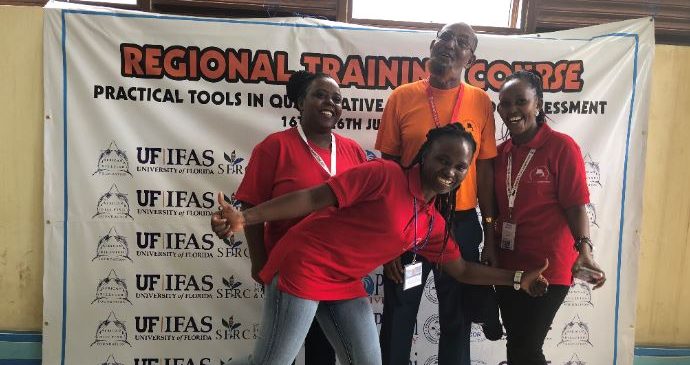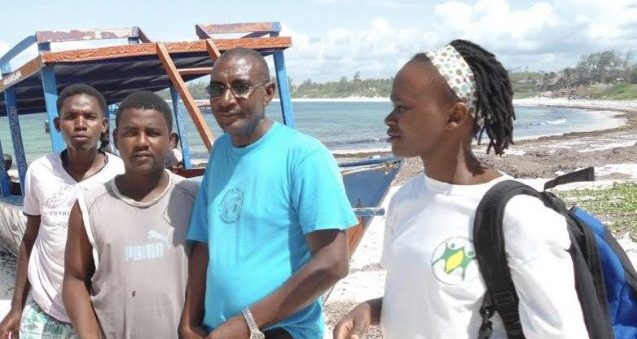Believe in yourself and do it
Nelly Isigi Kadagi , October 2019
Dr Nelly Isigi Kadagi is Director of Research for the African Billfish Foundation (ABF) and the Co-Principal Investigator for the BILLFISH-WIO project. She recently completed her Ph.D. from the University of Florida. She was team leader of a 2012 CLP project focused on blue and black marlin in the Western Indian Ocean. Nelly knows first-hand the importance of collaboration in conservation. Read part of her journey learning this lesson, and the ways she is now contributing as an international collaborator.

When and why did you choose a career in conservation?
As I was growing up in Western Kenya, my idea of the ocean was limited to the rivers in my village and pictures of sinking submarines in my family’s black-and-white television. Yet somehow, I had always wanted to work in the ocean. It was not until my third year of undergraduate studies that I first saw the Indian Ocean. At that point, all of my theoretical studies and beliefs started becoming real for me.
Is there an unusual or exciting wildlife encounter that has stayed with you? What happened and why was it impactful for you?
During my first job as a sea turtle researcher at a Kenyan-based sea turtle conservation organisation, I got a call from a hotel security guard who was reporting a sighting of a nesting turtle on the beach. This was about 3 a.m. I quickly jumped out of bed and got on my bicycle, which had no lights. I have no idea how I cycled in the dark. I got to the beach and found a group of Italian tourists who had gathered with flashlights to see the nesting turtle. In that moment I had to learn how to explain to the tourists why the flashlights were distracting to the sea turtle. Between my English and some broken Italian that I learned on the spot, it worked. The turtle nested quietly and went back to the sea.
This incident constantly reminds me why conservation work cannot be achieved by a single person or in a silo. It took the security guard remembering that it was me who was passionate about seeing turtles nest and return safely to the sea. It took the tourists who were willing to teach me some Italian words to explain to them why we needed to let the turtle nest peacefully. All of us needed to put together our collective efforts.
Describe your work and the primary conservation and management issues you are addressing.
I work at the intersection between science and policy, mostly focusing on billfish and other large pelagic fish species. The primary focus areas of my work are enhancing data collection, collation and sharing, and understanding the causes of fisheries conflicts and mitigation measures. There’s still limited information on billfish species in the Western India Ocean (WIO) region. Thus, I work with different stakeholders ranging from fishing communities to government institutions to improve data collection on billfish. For instance, for over 25 years, the ABF has collaborated with the sport fishing and artisanal fishing communities to collect data on billfish tagging and recaptures. This information has continued to contribute to our understanding of billfish species in the WIO region.
Funded by the Western Indian Ocean Marine Science Association (WIOMSA), the BILLFISH-WIO project brings together various collaborators from six countries (Somalia, Kenya, Tanzania, Mozambique, Madagascar and South Africa) to address various objectives that will contribute to sustainable billfish fisheries, livelihoods and governance. I am very excited to see the outputs of this three-year project that allows us to work with diverse stakeholders including early-career scientists and fishing communities.

What has been one of the most rewarding successes in your career to date? Why?
Witnessing the 2018 Regional Training in Quantitative Fisheries Stock Assessment come to fruition in Kenya with support from so many individuals and organisations. This training brought together 56 participants from eleven countries across Africa to share knowledge about assessing the status of our fish stocks. It has been a great opportunity and privilege to come to the USA and the University of Florida and study quantitative stock assessment for my Ph.D. – but what was more special and bigger than my doctorate degree was being able to convince my advisor, Dr Robert Ahrens, and one of my committee members, Dr Mike Allen, that it was possible to take a training to Kenya.
Briefly describe the objectives of your CLP project. How did CLP support make a difference to you?
The main goal of my 2012 CLP project was to advance knowledge on the threats and conservation status of the blue and black marlin through developing capacity for data collection and creating awareness. The CLP award built my confidence and provided a platform to develop my ideas about my contribution to conservation, whether it is from research, capacity building or taking part in policy-oriented initiatives. This was also the first time that a marlin project had been funded in my region, hence the opportunity enhanced my credibility in terms of delivering the outputs and working on sustainability of my work over the long term. Overall, I have grown personally and professionally since receiving this grant seven years ago.
The CLP Award also opened other doors for me within the WIO region. During my Ph.D., I got to work as a UN/FAO fisheries consultant tasked with enhancing data collection and reporting on recreational billfish and tuna in Kenya, Seychelles, Mauritius and Réunion.

What advice would you give to conservationists starting out in their career?
The young people that I meet and work with in my role as a scientist, educator and leader are my greatest inspiration. They are the future leaders and their energy and curiosity inspire me to keep building capacity and influencing change in any way I can.
My advice to them: believe in yourself and do it, and sometimes it may take a long time to see the results. But keep an open mind and stay hungry for knowledge.




